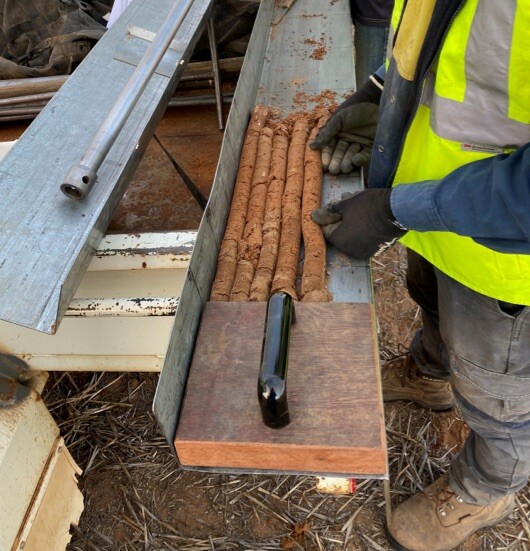Getting the most out of your deep soil nitrogen testing
Nitrogen budgeting and decision making can be made much easier if you know your starting soil nitrogen.

Key messages:
- Grain crops require plenty of nitrogen to deliver good yields, and when soils are nitrogen deficient, adding fertiliser into the system is necessary
- After a run of good seasons, a wet start to the year and record high fertiliser prices, how do you know what's in the N-Bank in your paddock? Is it going to meet the nitrogen needs of your crop needs this season?
- Your crops' ability to extract soil nitrogen and other nutrients depend on a healthy root system, which is unconstrained by nutrient deficiencies, soil acidity, sodicity or other structural issues. Incremental soil testing to a depth of 60cm will identify potential constraints caused by deficiencies.
Deep soil nitrogen testing
Deep Soil Nitrogen (DSN) testing is integral to managing your crops' nitrogen needs, indicating how much nitrogen is in the soil profile and in what form it is stored. DSN sampling generally involves collecting multiple soil cores to 60–100cm depth across a paddock. Cores are usually bulked together into one sample to produce a single stored-nitrogen value for each paddock.
Bulking together soil cores in this manner is problematic as it removes the ability to identify where the nitrogen stores are in the soil profile. For example, the breakdown of a recent pulse crop may result in an accumulation of nitrogen in the top 10cm of the soil profile. Alternatively, there may be a bulge of nitrogen at 90cm, beyond the reach of most roots (and at risk of leaching into groundwater). Or perhaps the top of the profile is nitrogen deficient, but there is an abundance just beyond the reach of young crops with shallower roots creating shortcomings in crop performance.
For this reason, DSN testing is best done over at least two depths (0-30cm, 30-60cm) to show how much nitrogen is available and where it is in the soil profile. These results can then inform a nitrogen budget to determine if the application of fertiliser nitrogen is required to meet target yields. An informed nitrogen budget also helps growers with rate and timing decisions.
DSN testing is ideally performed from mid-late March until June but can also occur in late winter-spring (adjusted for mineralisation and crop stage). While pre-sowing sampling gives an idea of 'what is in the bank' at the start of the season, a late June sampling better accounts for fertiliser applied at or after sowing, enabling the nitrogen requirement for a target yield to be determined more precisely.
Nitrogen stores may differ across paddock areas, so consider sampling from zones identified by electromagnetic (EM) or grid soil mapping, normalised difference vegetation index (NDVI) imagery, and yield mapping. Identifying nitrogen requirements by location can be helpful for variable rate applications (VRA) to match nitrogen requirements to different areas of the paddock.
Nitrogen budgeting
While most DSN tests include a nitrogen recommendation, growers can do their own calculations, especially if it's been a few years since the last soil test!
A basic nitrogen budget starts with the amount of plant-available nitrogen in the soil (nitrate-nitrogen + ammonium nitrogen on the soil test). It then adds an estimate of mineralisation (usually around 50kg N/ha) to give the total available nitrogen.
Once calculated, it can be determined if additional fertiliser is required. The target crop yield will inform the nitrogen fertiliser input requirement (wheat requires roughly 40kg N/ha to produce 1 tonne of grain, barley 35kg N/ha, and canola 80kg N/ha). If additional fertiliser is needed, consider its expected nitrogen use efficiency, which can be as low as 35%-50% due to conditions, disease, nitrogen gas losses, leaching or immobilisation.
Growers using nitrogen results from previous years will also need to factor in removal rates through grain, hay or pasture exports.
Summary
While adequate reserves might mean that urea is not always required, it's essential to understand nitrogen stores and their location to avoid limiting yield potential. Knowing what a paddock's N-bank is, allows farmers to make better decisions about how much nitrogen to apply and when it is needed. Avoid soil nitrogen mining each season (and then topping up at sowing) because the system needs a good amount of nitrogen in the soil over summer to support microbial activity and the breakdown of organic matter.
A final note is that while waterlogging isn't yet an issue for most soils across the Riverine Plains, this might change, and we may see increased losses of nitrogen from the system through leaching or denitrification.
For further information, consult your agronomist or soil-test provider.
Further reading
GRDC – nitrogen fertiliser use efficiency rules of thumb how reliable are they?
Nitrogen decision – Guidelines and rules of thumb
Refining deep soil nitrogen testing to reduce environmental losses (project report)
Author
NEWS
Keep up to date with the latest news from across the Riverine Plains.
-
Livestock
-
People
-
Grains
-
Sustainability

